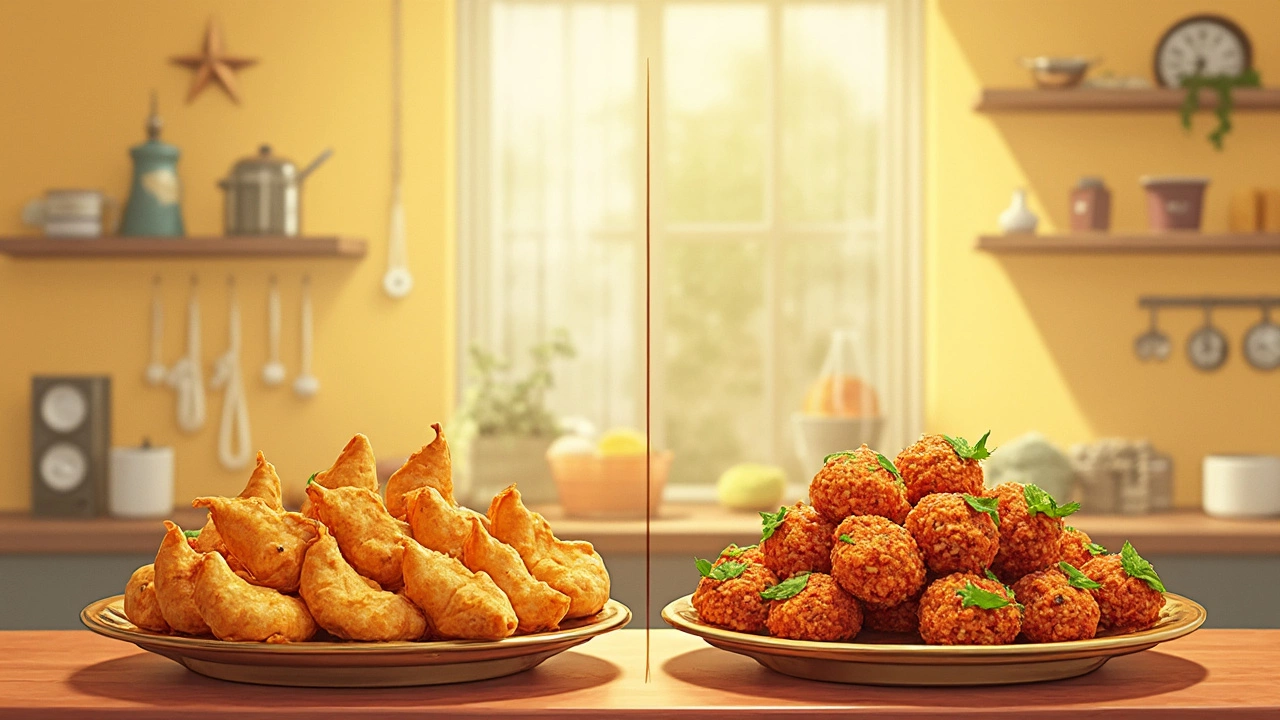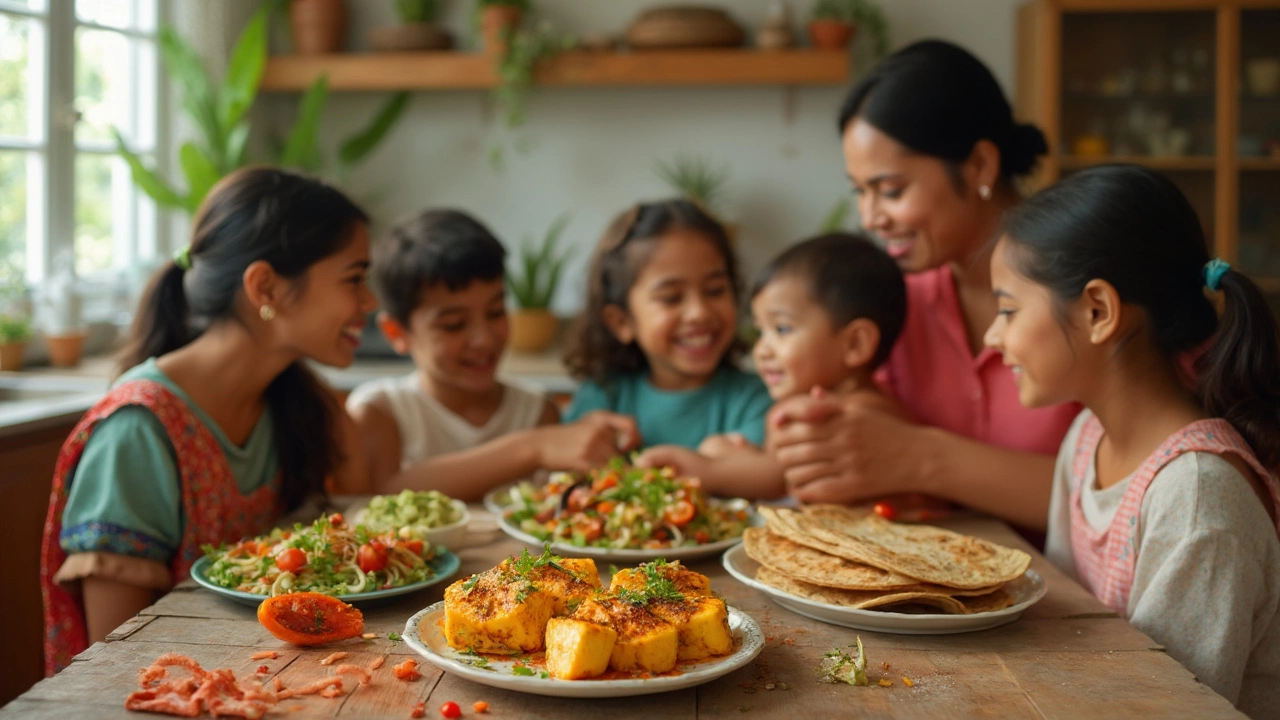Indian food gets a bad rap when it comes to weight loss, but honestly, a lot of those fears are based on half-truths. Sure, you see plenty of deep-fried samosas and buttery curries at restaurants, but home kitchens tell a different story. Everyday Indian meals can actually help you eat less processed food, add more veggies, and keep you full for hours.
So, what’s really making some Indian snacks lead to weight gain? Often, it’s the way street food and restaurant dishes are amped up with extra oil, sugar, or cream. Think about that giant plate of pav bhaji dripping with butter or a sweet jalebi soaking in syrup. You don’t have to cut out these favorites forever, but paying attention to how they’re made—and enjoying them in moderation—makes a bigger difference than the ingredients alone.
- Why People Think Indian Food Is Bad for Diets
- Hidden Healthy Gems in Indian Cuisine
- Smart Swaps: Making Snacks Lighter
- Go-To Indian Snacks for Weight Watchers
Why People Think Indian Food Is Bad for Diets
People have all sorts of ideas about indian food and weight loss, and not all of them are true. It’s easy to see why. When you walk into most Indian restaurants, the menu is loaded with things like butter chicken, naan slathered with ghee, or heavy gravies thickened with cream and nuts. It all feels rich and indulgent, especially when it’s paired with big portions.
Another reason? The way snacks are made for parties or street food. Samosas, pakoras, and chaat are usually deep-fried, making them higher in calories and fat. Add sweet desserts like gulab jamun and ladoos, and it’s clear why the cuisine seems off-limits for dieting.
The truth is, celebrations don’t reflect regular eating habits. Most Indian households don’t eat these every day. Still, these special-occasion foods have gone global, so they set the tone for what outsiders—and sometimes even locals—think Indian food is.
Check out how popular Indian snacks compare in calories and fat:
| Snack | Approx. Calories (per piece/serving) | Total Fat (g) |
|---|---|---|
| Samosa (fried) | 130 | 7 |
| Pakora (fried) | 75 | 4.5 |
| Gulab Jamun (one) | 175 | 6 |
| Bhel Puri (1 plate) | 150 | 2 |
| Sprout Chaat (homemade) | 100 | 0.5 |
There’s also a belief that Indian food is all about carbs—think white rice, potatoes, or breads like parathas. Most of these foods are filling, but if you eat oversized portions with lots of oil, the calories add up before you know it.
Cultural habits play a part too. Family meals often mean second helpings, which isn’t always great if you’re trying to lose weight. But if you’re mindful of what’s on your plate and how it’s cooked, Indian cuisine can be just as weight-loss-friendly as anything else.
Hidden Healthy Gems in Indian Cuisine
If you only focus on the oily or fried items, you miss out on the healthy side of Indian food that often gets ignored. At home, meals are usually packed with lentils, fresh veggies, spices, and grains that keep cravings in check and make meals naturally filling.
Take dals, for example. Lentil-based dishes like moong dal, masoor dal, and toor dal are loaded with protein and fiber, making them a smart choice if you're aiming for weight loss. They're comforting, low in calories, and cooked with just a bit of oil. Steamed idlis, dhokla, and poha also fit right into a healthy eating plan. Made with fermented rice or besan (chickpea flour), they're light yet keep you full from breakfast to snack time.
Spices do more than just flavor your meal—they can actually help boost metabolism. Turmeric, cumin, mustard seeds, and chili are all used daily and may even help your body burn a few extra calories after eating. It's one of the reasons why people say homemade Indian food keeps them satisfied for hours.
You might be surprised that a typical Indian thali (the wholesome spread with different small portions) has a nice balance of carbs, protein, fiber, and micronutrients. Here’s an idea of what a basic thali can look like:
| Item | Calories (approx.) | Main Nutrients |
|---|---|---|
| 1 cup dal | 140 | Protein, fiber |
| 1 roti (whole wheat) | 70 | Complex carbs, fiber |
| 1/2 cup mixed sabzi | 60 | Vitamins, minerals |
| 1 cup curd | 80 | Protein, probiotics |
Not bad for a full plate, right? If you skip the ghee (or use just a teaspoon) and load up on the sabzi, you actually get a meal that feels hearty but is easy on your waistline.
The key is looking past the heavy restaurant menu and focusing on the everyday stuff that’s already part of Indian home kitchens. If you crave something crunchy, roasted chana, murmura (puffed rice) with onions and coriander, or a bowl of fruit chaat make satisfying snacks. They’re fast, tasty, and way lower in calories than anything fried.
When it comes to indian food, the secret is in the details—how you cook things and what ingredients you use. You don’t need to give up Indian food to shed pounds. You just need to turn the spotlight on these underrated, healthy classics.

Smart Swaps: Making Snacks Lighter
If you think every Indian snack is loaded with oil and calories, good news: you can make some easy changes that’ll save a ton of calories and still keep things tasty. These smart swaps help you enjoy your favorites and make weight loss a lot less painful.
Baking instead of frying is a game-changer. Next time you crave samosas or pakoras, skip the deep fryer and bake them at home. The crunch is real, and you skip most of the grease. For crunchy snacks like mathri or namak para, try using an air-fryer. You still get the satisfaction but with way less fat.
- Use whole wheat flour instead of maida for snacks like dhokla, poha cutlets, or even homemade kachori. More fiber keeps you full longer and doesn't spike your sugar.
- Replace potatoes with paneer, chickpeas, or veggies like cauliflower for cutlets and tikkis. These add more protein and less starch.
- Spices actually help you. Stuff like cumin, black pepper, or ginger powder brings big flavor so you miss the butter and extra oil less.
- For chaat lovers, use roasted chana, sprouts, or moong dal as a base. Top with onions, tomatoes, and a squeeze of lemon instead of sev or papdi.
- Try steaming snacks. Idlis, dhokla, or even momos are classic examples where steaming locks in taste without piling on calories.
Watch portion sizes, especially with homemade snacks. It's easy to snack mindlessly, even on healthy stuff. Fill a small bowl with what you'll eat and put the rest away. Small adjustments like these go a long way—no need to ditch all your favorites to get fit.
Go-To Indian Snacks for Weight Watchers
If you think your only snack options are biscuits and namkeen, you’re missing out. Plenty of Indian snacks fit into a healthy eating plan, and you don’t have to put up with tiny portions or bland flavors. The trick is picking the right stuff and tweaking your recipes a bit.
First off, roasted chickpeas (chana) check all the boxes: high protein, fiber, and not loaded with empty calories. Just toss boiled chickpeas with a little oil and spices, and roast them till crunchy. Moong dal chillas are another big win. These protein-packed pancakes are made from ground moong dal, mixed with onions, chilis, and a handful of spices, then tossed on a nonstick pan—no deep-frying needed.
- Indian food isn’t just about heavy curries or fried snacks—look for steamed or roasted options like dhokla, idlis, or even sukha bhel (skip the sev and fried stuff).
- Sprouts salad with tomatoes, onions, lemon, and green chilis delivers on crunch and keeps you full. Experts recommend pairing it with buttermilk to boost your protein and hydration.
- Homemade popcorn (spiked with a pinch of chaat masala) is a lifesaver when those salty cravings hit.
- Boiled corn or sweet potato (shakarkandi) sprinkled with a little salt and chili powder is great for people tracking both calories and fiber.
The smartest move? Avoid store-bought packaged snacks. They hide a shocking amount of sodium and sugar, even in things that look "healthy." Check out this quick comparison of calories and major nutrients for popular choices:
| Snack | Calories (per serving) | Protein (g) | Fiber (g) | Approx. Fat (g) |
|---|---|---|---|---|
| Roasted Chana (30g) | 120 | 6 | 5 | 2 |
| Moong Dal Chilla (2 pieces) | 150 | 9 | 3 | 3 |
| Steamed Dhokla (50g) | 69 | 3 | 1 | 2 |
| Unbranded Mixed Namkeen (30g) | 160 | 3 | 1 | 9 |
| Samosa (1 piece) | 152 | 3 | 2 | 9 |
If you want variety, try switching up your dips. Hummus, mint chutney, and hung curd dip pumped with herbs make veggies exciting again. Batch-cook snacks on the weekend so you don’t reach for fried options when hunger hits—trust me, future you will be grateful!
